
| This site celebrates the life and work of sculptor John Cassidy (1860 - 1939). |
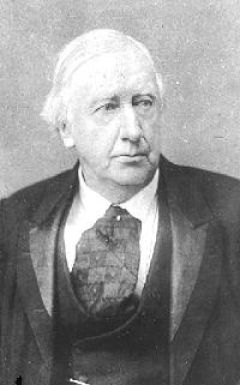
The photograph used by Cassidy.
Author's note
Compiling this feature has proved difficult, as although the works are documented, there are annoying gaps in the record. We are publishing it now in the hope that someone who sees it will be able to fill in the gaps and explain how the works came to be where they are today.
If you can help, or have any comments at all, please get in touch at the email address below.
The New Gallery
Charles Edward Hallé (1846-1914), son of Sir Charles Hallé, trained as a painter, and in 1888, with art critic Joseph Comyns Carr, he founded 'The New Gallery' in a building on the site of an old fruit market at 121 Regent Street, London. Cassidy exhibited works there a number of times - perhaps C.E. Hallé himself suggested his father as a subject.
The New Gallery flourished for a number of years, supported by the likes of Edward Burne-Jones, G.F. Watts and Lord Leighton, as well as followers of the Arts and Crafts Movement, but after about 1905 it went into a decline, and in 1910 it closed. The building (Listed Grade II as of historic importance) is still there, and has seen several uses over the last century: restaurant, cinema, Seventh-day Adventist Church, Habitat furniture store, and since 2011 a store for the Burberry clothing company.
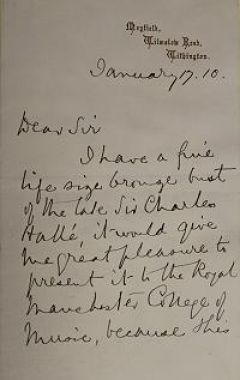
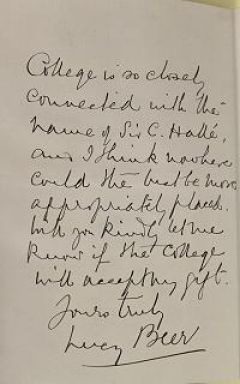
Mayfield
Wilmslow Road
Withington
January 17. 10.
Dear SirWilmslow Road
Withington
January 17. 10.
I have a fine life size bronze bust of the late Sir Charles Hallé, it would give me great pleasure to present it to the Royal Manchester College of Music, because this College is so closely collected with the name of Sir C. Hallé, and I think nowhere could the bust be more appropriately placed. Will you kidnly let me know if the College will accept my gift.
Yours truly
Lucy Beer
Lucy Beer
Minutes of the Council, Royal Manchester
College of Music, 19 January 1910. Item 91:
Read a letter from Mrs Walter Beer offering to present a life-sized bronze bust of the late Sit Charles Hallé to the College.
Resolved: That the Council has heard with great pleasure of the intention of Mrs. Walter Beer to present to the College a bust of the late Sir Charles Hallé, and, in accepting the same, begs to assure Mrs Walter Beer of its appreciation of her generous and appropriate gift.
Read a letter from Mrs Walter Beer offering to present a life-sized bronze bust of the late Sit Charles Hallé to the College.
Resolved: That the Council has heard with great pleasure of the intention of Mrs. Walter Beer to present to the College a bust of the late Sir Charles Hallé, and, in accepting the same, begs to assure Mrs Walter Beer of its appreciation of her generous and appropriate gift.
Signed
Alfred Hopkinson
Some years later, Alfred Hopkinson was himself portrayed by Cassidy with both a bust and a statuette. See our feature.
Hucketts and Beers
Who was 'Mrs Walter Beer' who presented the bust, previously owned by Mrs Rylands, to the Royal Manchester College of Music? What follows attempts to answer this question.
The life of Mrs Rylands is related in our feature about her statue in the John Rylands Library. She lived in Longford Hall, Stretford with her husband John Rylands, and continued to do so after he died. The couple were deeply involved with non-conformist religion, and Congregationalism in particular, and through this interest became acquainted with the Huckett family.
Henry Huckett, born in Newport Pagnell, Buckinghamshire, was a draper, with a shop in the High Street of Market Harborough, Leicestershire. The 1871 census shows him living there with his wife Anne Huckett (née Sharman) and children Edward Huckett (aged 14), Fanny Sharman Huckett (13), William (11), Walter (9) and Lucy (7) as well as two young apprentices in the drapery trade - that is, dealing in cloth and clothing.
Of their sons, Edward Huckett became a shopkeeper in Grimsby, Lincolnshire, and William Huckett made his living a commercial traveller for a cotton thread manufacturer. Neither plays any more part in our story.
Walter Huckett (1862-1947) trained as a Minister at the Lancashire Independent College in Manchester, where he probably met Mrs Rylands, and took to the life of a Missionary, working in Madagascar and Samoa for the London Missionary Society. By 1911 he had settled in Torquay, Devon with his wife Margaret. They had four children: sons Arnold Walter Huckett, born in Madagascar, and Oliver Sharman Huckett, born in Samoa, both died in World War I. Walter wrote an obituary tribute to Mrs Rylands in the Lancashire Congregational Yearbook for 1908 (p. 102-3.)
Anne Huckett died in 1877. It appears that her daughter Fanny Sharman Huckett met Mrs Rylands shortly afterwards, and moved in to Longford Hall, perhaps after the death of John Rylands in 1888.
Lucy Huckett became a governess: in 1881 she was teaching the children of Benjamin Baldwin, a jeweller, in Loughborough, Leicestershire, and in 1891 she was a 'school governess' living with her father who had retired and was living at Brunswick Lodge, 5 Raleigh Villas, Exmouth, Devon.
Henry Huckett died in Devon in 1899, and by 1901 both Lucy and Fanny were living at Longford Hall. As the decade progressed, Mrs Rylands spent less and less time at Longford Hall, preferring her other houses in Buxton, Derbyshire, in Queens Gate, South Kensington, and latterly 'Fairholme' in Torquay, Devon which she bought in 1905. She died in Torquay in 1908, leaving a large fortune. In her will she left £6000 to Walter Huckett in Samoa, and to Fanny Sharman Huckett; 'her residence, Northwood, Buxton, all effects there, such of her effects at Torquay as she shall select ... £30,000 in cash, and £50,000 in shares in Rylands Ltd, as well as a share in the residuary estate.'
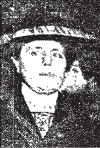 These
sums are equivalent to several million pounds today. Fanny
elected to live at the Torquay House, 'Fairholme' - the 1911
census shows her living there 'alone' that is,
attended by seven servants. She was invited to perform the
ceremonial opening in 1911 of the Congregational Church
House (Milton Hall) in Deansgate, Manchester on 21 February
1911; the image shown here is from a press photograph of the
event. Donation of funds for the building was one of Mrs
Rylands' last provisions before her death. Fanny never
married, and later lived in London at 13 Lowndes Square,
Knightsbridge until her death in 1928 while staying at the
Park Hotel, Gstaad, Switzerland. Her body was returned to
Manchester and is buried in Southern Cemetery close to the
Rylands family grave. (Non-conformist section, E 8387). She
left an estate of £156,000, so she must have made good use
of Mrs Rylands' bequest.
These
sums are equivalent to several million pounds today. Fanny
elected to live at the Torquay House, 'Fairholme' - the 1911
census shows her living there 'alone' that is,
attended by seven servants. She was invited to perform the
ceremonial opening in 1911 of the Congregational Church
House (Milton Hall) in Deansgate, Manchester on 21 February
1911; the image shown here is from a press photograph of the
event. Donation of funds for the building was one of Mrs
Rylands' last provisions before her death. Fanny never
married, and later lived in London at 13 Lowndes Square,
Knightsbridge until her death in 1928 while staying at the
Park Hotel, Gstaad, Switzerland. Her body was returned to
Manchester and is buried in Southern Cemetery close to the
Rylands family grave. (Non-conformist section, E 8387). She
left an estate of £156,000, so she must have made good use
of Mrs Rylands' bequest.Lucy Huckett did not stay long at Longford Hall: in 1903 she married Walter Michael Beer, to become, in the convention of those times, the 'Mrs Walter Beer' who presented the Hallé bust. She is not named in Mrs Rylands' will, but one can imagine how the work came to her during the general distribution of Mrs Rylands' effects by her sister in preparation for the sale of Longford Hall. How she might also have obtained the statuette, which Cassidy claims went to America, is a mystery. Perhaps the attribution to her of the statuette is the result of a confusion of records, or maybe Cassidy was mistaken ... or more than one copy was cast.
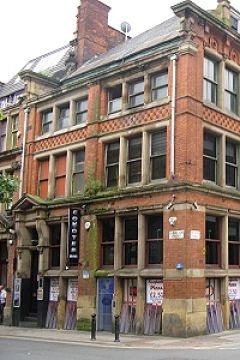
Walter Michael Beer, born in Manchester in 1861, was a son of Adolphus Beer, a German-born cotton merchant, and joined his father's business at 14 Chorlton Street, Manchester (pictured above) where he also operated as the Honorary Consul for Paraguay, a fact which gives a clue to the nature of the firm's export business.
Although Lucy was about 40 years old when they married, the couple had two sons, Adolphus Sharman Beer (1904 - 1983) and Ronald Walter Beer (1906 - 1985).
Sharman Beer (he understandably dropped his first name) studied medicine in Manchester, then worked at Manchester Royal Infirmary and the Radcliffe Infirmary Oxford. He became outpatient assistant at Royal National Throat, Nose and Ear Hospital in London.
Later, he practised as a General Practitioner in the town of Thame, Oxfordshire, where he is commemorated by Sharman Beer Court, a sheltered housing development built in 1989. He was a Major in the Royal Army Medical Corps during World War II.
Walter Michael Beer died in 1927, and his funeral at Manchester Crematorium was conducted by the Rev. Jacob Phillips of the Park Place Synagogue and attended by many members of the Manchester Jewish community.
Another bust
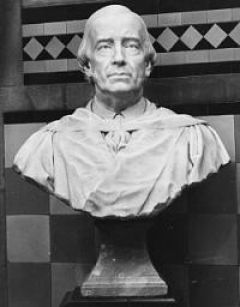
Another bust of Hallé on public display in Manchester can be found in the Sculpture Hall of Manchester Town Hall, in Albert Square. Made in marble by Cassidy's contemporary Edward Onslow Ford (1852 - 1901).
This bust was paid for by public subscription in memory of Hallé, and was presented to the City Art Gallery in 1897.
Onslow Ford also created the large monument to Queen Victoria in Piccadilly Gardens, Manchester, commissioned originally for the Queen's Golden Jubilee, but not finished until 1901 by which time the Queen had died, and the sculptor himself passed away soon afterwards.
Thanks to:
Mary Ann Davison of the Royal Northern College of Music, who kindly arranged for me to visit the statuette and provided documents from the College archives.
Eleanor Roberts, Trusts & Research Manager of the Hallé Orchestra, who kindly arranged for a photograph of the plaster bust.
Sheila Dewsbury of the Manchester Academy of Fine Arts, for the picture from the Academy archive.
Catherine Beer, for information about the Beer family.
The staff of the John Rylands Library and Manchester Local Studies Library.
Sir Charles Hallé (1897)
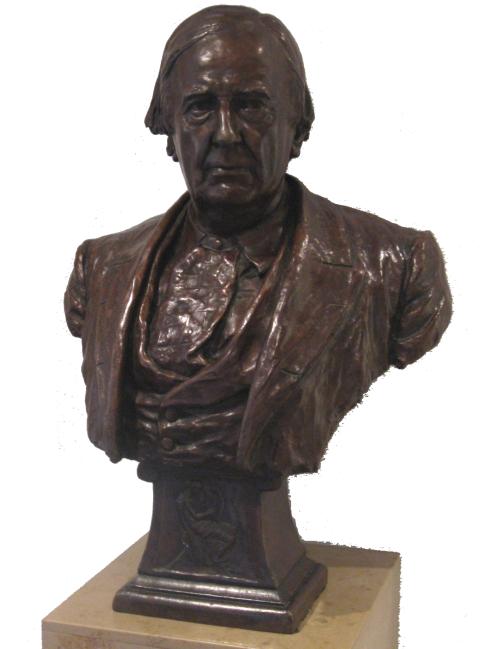
We'll start our story with a newspaper clipping:
Sir Charles Hallé's portrait - Mr. John Cassidy writes from Woodheys Grange, Ashton-on-Mersey.- I see in your issue of Wednesday that the portrait offered for sale at a public auction on Tuesday is reputed to be the only portrait in existence of the late Sir Charles Hallé. May I point out that this is hardly correct since I myself have executed three portraits of him - a lifesize bust, a statuette, and a lifesize bas-relief? All were cast in bronze. The bust, when in the Royal Academy exhibition, was purchased by the late Mrs Rylands, and it was subsequently presented to the Manchester School of Music. The statuette appeared at the New Gallery show a year later, and this was purchased by an American, who took it to the states. The bas-relief was in the possession of a member of the orchestra, but I have lost sight of this altogether. - Manchester Guardian, 27 November 1930, p. 11.This little piece from late in Cassidy's career, 33 years after he made the portraits, gives us some hints about the history of two of his works which are known to survive in Manchester today, and one - the bas-relief - the whereabouts of which remain a mystery. What the item doesn't tell us is how it came about that Cassidy tackled this subject. Hallé died in 1895, and Cassidy modelled him shortly afterwards; it's clear that the worked from the photograph we reproduce here.
Charles Hallé
Sir Charles Hallé (born Karl Halle) conductor and pianist, was born on 11 April 1819 in Hagen, Westphalia. He had his first piano lessons at the age of three and soon showed extraordinary talent. In 1835 he went to Darmstadt to study, and the following year moved on to Paris, where he was soon in demand as a pianist. In Paris he met and mixed with musicians such as Richard Wagner, Chopin, Liszt, and Paganini, and Berlioz, as well as literary figures and artists.He visited England in 1843, and when the 1848 revolution broke out in Paris he escaped to Britain with his wife, Désirée Smith de Rilieu. Initially he settled in London, until he received a letter from a Manchester calico printer, Hermann Leo, informing him that Manchester was quite ripe to be taken in hand' and that Leo considered him ‘the fittest man to stir the dormant taste for the art’ (quotes from his autobiography).
Hallé accepted the offer and visited Manchester in September 1848 to play Beethoven 'Emperor' concerto. His first contribution to Mancunian musical life was to found a series of chamber concerts. In November 1849 he was appointed conductor of the Gentlemen's Concerts, which had been established about 1770, and re-formed the orchestra. He also gave piano recitals. His first home in Manchester was 3 Addison Terrace, Victoria Park, which still exists and carries a commemorative blue plaque to him and also painter Ford Madox Brown who lived there from 1883 to 1887 while painting the murals in Manchester Town Hall. Later Hallé and his family moved to a house (now demolished) at 70 Greenheys Lane, Manchester, then a semi-rural district famously commemorated in the opening chapter of Elizabeth Gaskell's novel Mary Barton. Blue commemorative plaques have marked both sites; the site of the Greenheys Lane house later became the site of a housing development named Duxbury Square, which itself no longer exists.
In 1857 Manchester staged the great Art Treasures Exhibition in Old Trafford and Hallé was engaged to lead an orchestra which would play there. At the end of the exhibition in October he decided to retain the Orchestra and establish his own concerts at the Free Trade Hall in Manchester which had recently been rebuilt. Thus was founded the world-famous Hallé Orchestra which still performs today, at the Bridgewater Hall, successor to the Free Trade Hall which has been turned into a hotel.
His first wife died in 1866. In 1888 he received a Knighthood, and in July 1888 he married a long-time friend, the violinist Wilma Norman-Neruda and with her he toured Australia in 1890 and 1891 and South Africa in 1895.
In 1893 he became the first principal of the Royal Manchester College of Music, which opened in October that year as a result of an initiative taken four years earlier to mark Hallé's seventieth birthday. Its building was in Ducie Street (now Devas Street), on the southern edge of the University area.
He died at home on 25 October 1895 and is buried on 29 October in the Roman Catholic cemetery at Weaste, Salford.
The Royal Manchester College of Music merged in 1972 with the Northern School of Music, founded in 1920 for the training of music teachers and based in a building on Sydney Street, off Oxford Road in All Saints, Manchester.
The combined institution was named the Royal Northern College of Music, for which a new building was opened on Booth Street west adjacent to the University Campus. The building was opened in 1973 and has been considerably extended since.
The bust
The bronze bust is recorded as exhibit 2047 at the Royal Academy, London, in 1897, confirming Cassidy's own recollection. It appeared again at the Spring Exhibition of the Manchester Academy of Fine Arts at Manchester City Art Gallery in 1898 (no. 299), and again at the City Art Gallery's own Seventeenth Autumn Exhibition, 1899, described as 'on sale by commission in bronze for £105.' The last item suggests that the plaster model for the bust was retained by Cassidy for the possible production of further copies.
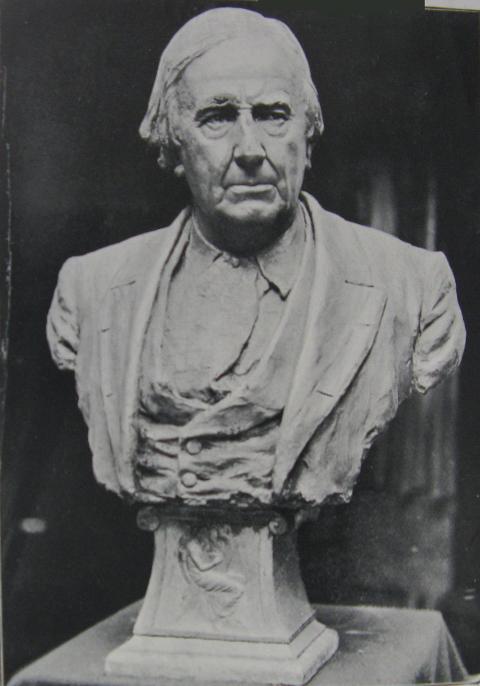
At some time, the plaster model (pictured above) came into the possession of the Orchestra, and was coloured black to simulate bronze. It still exists, also kept in the Bridgewater Hall, within the offices of the Hallé Orchestra.
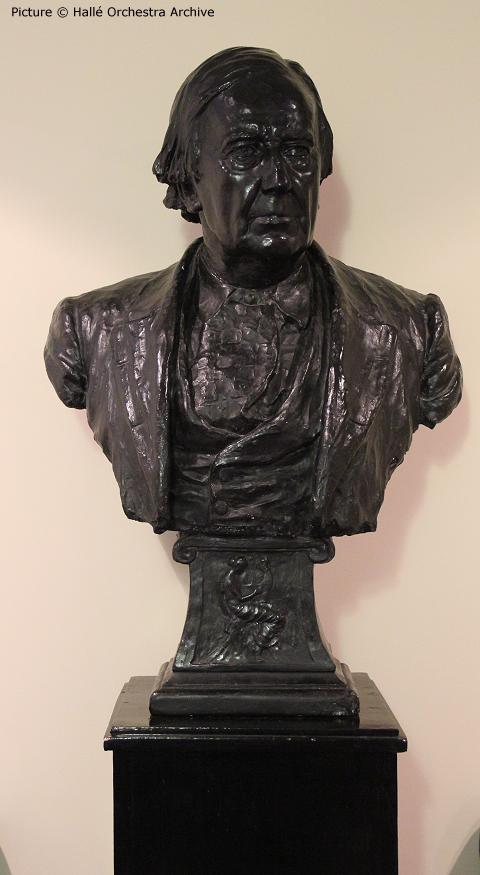
This picture kindly supplied by the Hallé archivist shows the plaster version as it stands in 2012. It made a public appearance in 2008: According to an article in The Guardian of 29 January 2008 about a 150th anniversary concert, 'The current music director, 60-year-old Mark Elder, stops on his way to the podium and looks up at a bust of Charles Hallé, peering down from the choir stalls. It is a black-painted piece of Victoriana, a little scratched and worn, and seems out of place in the modernity of the Bridgewater Hall.'
Mrs Rylands, purchaser of the bronze bust, was Enriqueta Augustina Rylands, widow of cotton millionaire John Rylands and founder of the John Rylands Library in Manchester. She was a significant patron of Cassidy and the subject of one of his major works: see our feature on her and her work. She owned several houses, including Longford Hall in Stretford, outside Manchester which had been her home (with her husband until his death in 1888) since 1857. The bust is mentioned, with the picture (reproduced above) of the plaster model, in a feature on Cassidy in the May 1903 issue of Manchester Faces and Places (reproduced elsewhere on our site): 'The late Sir Charles Hallé, from a bronze bust now in the possession of Mrs Rylands, Longford Hall.'
Mrs Rylands died in 1907, and Longford Hall with its surrounding parkland was sold in 1911 to Stretord Urban District Council as a public amenity. Unfortunately the Hall, except for its facade, was demolished in 1995, but Longford Park remains as popular green space, with an active Friends Group.
The bust is mentioned in Michael Kennedy's book The History of the Royal Manchester College of Music, 1893-1972 in which we read that in 1910 'John Cassidy's life-size bust of Hallé, which stood in the Lees Hall, was presented to the College by Mrs Walter Beer.' (The Lees Hall was the concert hall of the college.) Happily the original records of this gift have been preserved in the Royal Northern College of Music archives (see left column).
Unhappily, however, the ultimate fate of the bust presented to the College is unknown. Did it survive until the College left the the Devas Street building in 1973? Was it left behind, stored in some forgotten room, sold, given away, or discarded? The Devas Street building, adjacent to the area of the University of Manchester, was left empty by the College, and notoriously occupied squatters before being taken over (known to all as 'The Squat') by the University Students' Union, deteriorating until it was demolished in 1982. If you can add to the story, please get in touch.
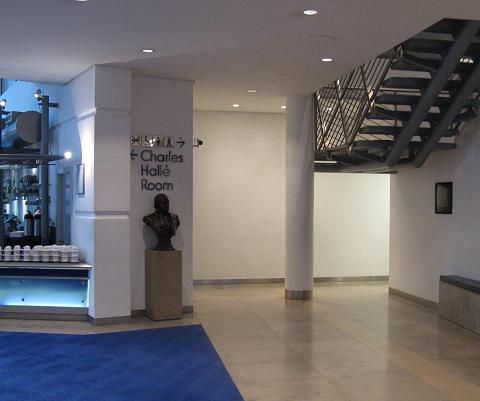
The bust which now sits on a wooden plinth in the foyer of the Bridgewater Hall, near the entrance to the Charles Hallé Room, a meeting room which is available for hire, is a new casting made from the plaster version for the opening of the Hall in 1996, and could be described as the 'newest' of all Cassidy's works.
The Statuette
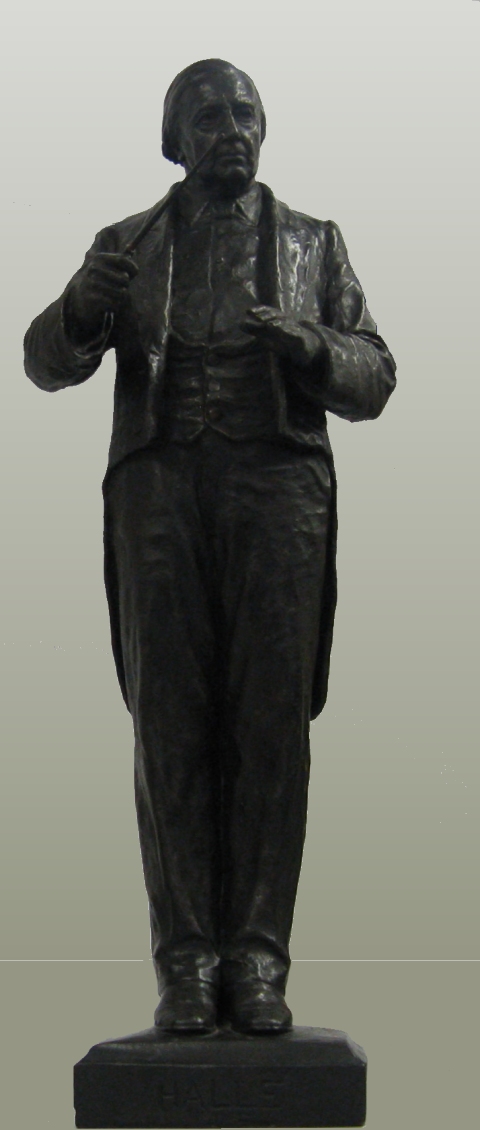
This little bronze work, about 700mm high, showing Hallé in the act of conducting (with a baton which is cast as a separate item) is today kept in the archives of the Royal Northern College of Music.
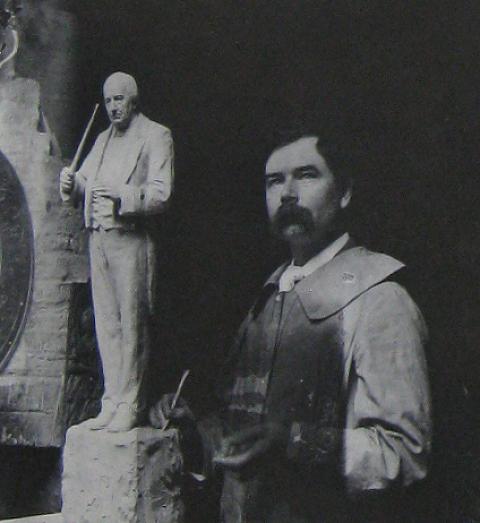
Cassidy with the plaster model in his Lincoln Grove studio, 1897. It appears to be mentioned in the article 'An Hour with a Sculptor' (also available here) from the Manchester Evening Chronicle in 1899: '...at Longford Hall a superb statue of Sir Charles Hallé is the subject of much attention on account of the faithfulness and exquisite finish.' This may, however, possibly be a reference to the bust.
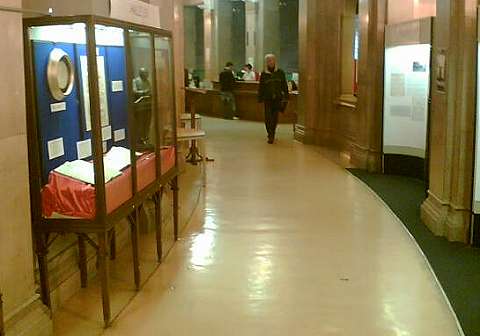
It has been on public display in the College from time to time, and was loaned to Manchester Central Library in 2008 for an exhibition commemorating the 150th anniversary of the Hallé Orchestra. This can be seen in our picture above, which itself is now historic as the Library has undergone a total internal rebuild.
The College archives reveal no information about how the statuette, stated by Cassidy to have been taken to America, came to be in the College. A photograph of it, taken during its time in the Royal Northern College of Music, appears on Page 7 of the book Charles Hallé: a Musical Life by Robert Beale with a caption including the statement 'A plate identifies this as Sir Charles Hallé by John Cassidy, the gift of Mrs Walter Beer'. When kindly allowed by the College archivist to inspect the work in 2011, we did not see this plate which was perhaps affixed to a plinth.
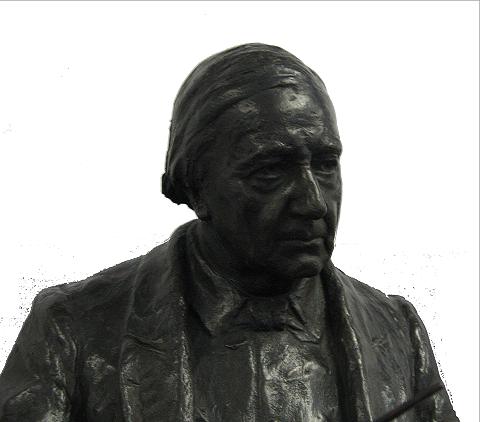
Detail of the statuette.
Bibliography
Robert Beale, Charles Hallé: a Musical Life. Aldershot: Ashgate Publishing, 2007
Michael Kennedy, The History of the Royal Manchester College of Music, 1893-1972 Manchester: Manchester University Press, 1971.
Michael Kennedy (ed), The autobiography of Charles Halle : with correspondence and diaries. London, Elek Books, 1972.
Michael Kennedy, 'Hallé, Sir Charles (1819–1895)', Oxford Dictionary of National Biography, Oxford University Press, 2004
Enriqueta Rylands, Who Do You Think She Was?: Discovering the Founder of the John Rylands Library Manchester: John Rylands University Library, 2008. Booklet printed to accompany an exhibition of the same title.
Written by Charlie Hulme, Summer 2012. Updated July 2015.